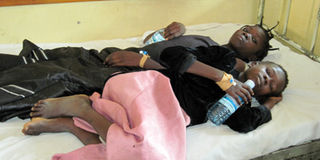Arua hospital where ‘the sick get more sick’

Patients share a bed at Arua Regional Referral Hospital. The hospital has a 272-bed capacity hospital yet it serves a catchment area covering an estimated 2.8 million people PHOTO BY FELIX WAROM OKELLO.
What you need to know:
Congestion, dilapidated structures, poor financial support, staff shortage, among others have become the mainstay of the referral hospital for years even with government knowledge.
Arua
On any given day, Arua Regional Hospital can be a scene of activity. But it can also give you an apt description of the despair and struggles that the hospital goes through to provide services to the people.
Congested, with dilapidated buildings, it is common to find patients sleeping away in corridors—on bare concrete floors because the beds are not enough. Some squeeze to sleep under the beds. Patients are exposed to dangers of contracting new diseases as they share bedding.
The stench from the lavatory next to the corridor is nauseating. A patient asking for some help from passersby at the female ward whispers: “It is nothing more than a jail. It is not for people like you.” Established in 1939, the hospital which was elevated to a regional referral status in 1994, faces the same challenges as several hospitals across the country.
The troubles of this hospital have been mostly financial. According to the senior records Officer, Mr Bosco Alionzi, the government still considers the hospital to be a 272-bed capacity hospital even though this has since changed. With growing population overtime, and a catchment area covering an estimated 2.8 million people, there hasn’t been a significant increase in the number of beds and other basic infrastructure including human resources needed to run the hospital.
The hospital receives patients from neighboring Democratic Republic of Congo and South Sudan.
With a quarterly budget of Shs1.2 billion for both drugs and other supplies and other administrative costs, hospital authorities say this money cannot cater for the ever increasing demands and cost of providing healthcare.
Staff shortages
Recruitment of new staff has been constrained by a ceiling put by the Ministry of Public Service. A patient, Ms Susan Adiru, soberly says: “I wish one day the President visits any of this hospital and gets first-hand knowledge of people’s problems.”
The overwhelming number of patients also strains the available staff. There are currently only 14 doctors against the recommended 39.
There are 166 nurses, eight clinical staff and four anesthetics. It has four consultants (among whom one handles psychiatry and one Obstetrician, one Surgeon, and one Ophthalmologist), One Medical Official on Special Grade and seven medical officers.
The hospital director, Dr Bernard Odu, describes the situation as pathetic. “The country does not budget for non-citizens who, according to hospital officials, constitute about 20 per cent of patients registered at Arua referral hospital,” Odu said. The death of Jennifer Anguko who had come for delivery, put the hospital on the spotlight. The case is still being handled.
Leader of the Opposition in Parliament Nandala Mafabi, during a visit to the hospital last year, said: “The people of Uganda pay taxes in order to get services. You get medical staff looking after 60 patients, poor toilets, mama kits are not provided for mothers. If you are sick, you become sicker because the staff is overwhelmed because patients are on the cold and dirty floor.”
The few staff members are trying to be resilient. The Ministry of Health through Parliament appropriates finances based on bed capacity of the health facilities and its catchment population.
Unending woes
Things are not different from the time former Health minister Christine Ondoa, visited the hospital in February this year. She said there was need for expansion of the hospital. And that government has plans to raze down the old wards and construct a modern one to create space.
A nurse at Female ward on duty, who declined to be named since she is a junior, said: “It is stressful for us due to overwhelming number of patients. By this one completes their duty, they are exhausted and it is dangerous to our health.”
The construction of a 144-bed ward and a 20-bed capacity private self-contained ward was completed in June 2010 but to date, it has never been opened for use.
Presently, the hospital manages its effluents on-site using septic tanks and soak pits, which often fill up, spewing human waste down River Osu which is the main water source for residents of Bibia slum quarters.
The Obongi County MP, Mr Hassan Fungaroo, said: “Our ruling class always gets treatment from abroad for even minor ailments. Miseries and problems of a common man are not their problems.”




